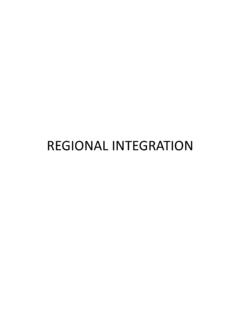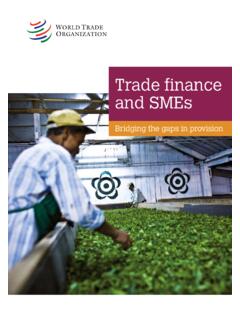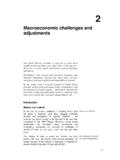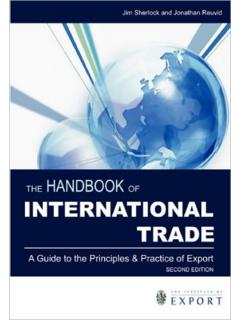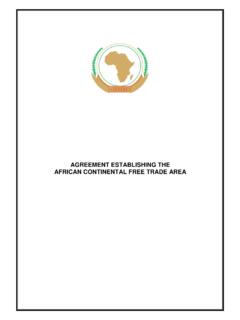Transcription of GUIDANCE ON NON-PREFERENTIAL RULES OF ORIGIN
1 GUIDANCE ON NON-PREFERENTIAL . RULES OF ORIGIN . December 2018. Taxation and Customs Union Disclaimer It must be stressed that this document does not constitute a legally binding act and is of an explanatory nature. Legal provisions of customs legislation take precedence over the contents of this document and should always be consulted. The authentic texts of the EU legal instruments are those published in the Official Journal of the European Union. There may also exist national instructions or explanatory notes in addition to this document. 2. Contents 1. Introduction of the GUIDANCE on NON-PREFERENTIAL ORIGIN .. 5. Difference between customs status and ORIGIN .. 5. Scope of application of the NON-PREFERENTIAL RULES of ORIGIN .. 6. 2. Release for free circulation of 7. concepts for the determination of the NON-PREFERENTIAL ORIGIN : article 60 UCC and articles 31-36 UCC-DA.
2 7. Only one country is involved in the manufacture of the product .. 7. Two or more countries are involved in the manufacture of the product .8. The determination of ORIGIN where two or more countries are involved in the production .. 11. Determination of ORIGIN for products which are included in the Annex 22-01 UCC-DA ..11. Determination of ORIGIN for products which are not included in the Annex 22-01 UCC-DA ..16. Checking the declared ORIGIN and proof of ORIGIN .. 17. Checking of the NON-PREFERENTIAL ORIGIN for products not subject to special NON-PREFERENTIAL import arrangements .17. Checking of the NON-PREFERENTIAL ORIGIN for products which are subject to special NON-PREFERENTIAL import arrangements (Article 61(1) and (2) of UCC) ..19. Incorrect declaration of NON-PREFERENTIAL ORIGIN in the declaration for release for free circulation.
3 20. 3. Export of goods .. 20. 3. Relevant legislation (and its amending and correcting acts which are not listed): Regulation (EU) No 952/2013 of the European Parliament and of the Council of 9 October 2013 laying down the Union Customs Code (OJ L269 of ) hereafter referred to as UCC. Articles 59-63. Commission Delegated Regulation (EU) 2015/2446 of 28 July 2015 supplementing Regulation (EU) No 952/2013 of the European Parliament and of the Council as regards detailed RULES concerning certain provisions of the Union Customs Code (OJ L343 of ) hereafter referred to as Delegated Act UCC-DA. Articles 31-36, Annex 22-01. Introductory notes and list of substantial processing or working operations conferring non- preferential ORIGIN . Commission Implementing Regulation (EU) 2015/2447 of 24 November 2015 laying down detailed RULES for implementing certain provisions of Regulation (EU) No 952/2013 of the European Parliament and of the Council laying down the Union Customs Code (OJ L343 of ) hereafter referred to as Implementing Act UCC-IA.
4 Articles 57-59. Abbreviation/Acronym Definition UCC Union Customs Code UCC-DA Delegated Act UCC-IA Implementing Act BOI Binding ORIGIN Information decision BTI Binding Tariff Information decision WTO World trade Organisation WTO ARO World trade Organisation Agreement on RULES of ORIGIN HS Harmonised System CN Combined Nomenclature EU European Union ECJ European Court of Justice CC change to the chapter in question from any other chapter CTH change to the heading in question from any other heading change to the subheading in question from any other CTSH. subheading or from any other heading change to the split heading in question from any other split of CTHS. this heading or from any other heading change to the split subheading in question from any other split CTSHS. of this subheading or from any other subheading or heading 4.
5 1. Introduction of the GUIDANCE on NON-PREFERENTIAL ORIGIN The aim of the non-binding GUIDANCE is to provide assistance for economic operators and customs authorities in understanding and applying the RULES on the determination of non- preferential ORIGIN of goods in the EU. ORIGIN is the "economic" nationality of goods traded in commerce. The customs treatment upon release for free circulation of goods is determined by three elements: tariff classification, customs value and ORIGIN of the goods. There are two types of ORIGIN : preferential ORIGIN and NON-PREFERENTIAL ORIGIN . Preferential ORIGIN is conferred on goods from particular countries when they fulfil the RULES of ORIGIN provided for in the relevant preferential arrangement. In this case, the goods could benefit from a reduced customs duty or even free of duty.
6 It should be noted that not all products necessarily have a preferential ORIGIN . NON-PREFERENTIAL ORIGIN RULES are used for the application of all kinds of NON-PREFERENTIAL commercial policy measures, like, for instance, anti-dumping duties and countervailing duties, trade embargoes, safeguard measures, ORIGIN marking requirements1, quantitative restrictions or tariff quotas, government procurement and trade statistics. NON-PREFERENTIAL ORIGIN is obtained where goods are "wholly obtained" in one country or, when two or more countries are involved in the manufacture of a product, ORIGIN is obtained where goods underwent their last, substantial, economically-justified processing or working, in an undertaking equipped for that purpose, resulting in the manufacture of a new product or representing an important stage of manufacture.
7 Every product necessarily has a NON-PREFERENTIAL ORIGIN , which could be different from its preferential ORIGIN . In what follows in this GUIDANCE , the word ' ORIGIN ' refers to NON-PREFERENTIAL ORIGIN . Difference between customs status and ORIGIN The 'customs status of goods' and ' ORIGIN of goods' are 2 different concepts, serving different purposes. Customs status means the status of goods as Union or non-Union goods (Art 5 (22) UCC), this status is independent of the ORIGIN of goods. The customs status of goods does not affect the ORIGIN of the goods. Consequently, for goods that are of EU ORIGIN which are released for free circulation in the EU, the applicable duties will have to be paid when the goods have the customs status of non- Union goods. The Union customs status is obtained after completion of the procedures for release for free circulation and payment of the applicable duties.
8 1. Regulation (EU) n 1169/2011 of the European Parliament and of the Council of 25 october 2011 on the provision of food information to consumers INCO . 5. Scope of application of the NON-PREFERENTIAL RULES of ORIGIN The NON-PREFERENTIAL RULES of ORIGIN apply to goods declared for release for free circulation in the EU for the purpose of applying the Common Customs Tariff, except where it concerns preferential tariff measures. They are also used for the application of other measures established by Union provisions governing specific fields relating to trade in goods, like anti- dumping measures or ORIGIN marking requirements. Establishing harmonised NON-PREFERENTIAL RULES of ORIGIN among WTO members is the objective of the Harmonisation Work Programme laid down in the Agreement on RULES of ORIGIN (by Decision 94/800/EC the Council approved the Agreement on RULES of ORIGIN (WTO-GATT 1994), annexed to the final act signed in Marrakesh on 15 April 1994).
9 While awaiting the finalisation of this work program, any country can apply its own NON-PREFERENTIAL RULES of ORIGIN at release for free circulation. The RULES applied by WTO members should comply with the principles laid down in the Agreement on RULES of ORIGIN . Due to the fact that any third country can apply its own NON-PREFERENTIAL RULES of ORIGIN , the use of EU NON-PREFERENTIAL RULES of ORIGIN is not mandatory for export, the only exception is in case Union measures relating to the ORIGIN of goods exist, like for instance export refunds. 6. 2. Release for free circulation of goods concepts for the determination of the NON-PREFERENTIAL ORIGIN : article 60. UCC and articles 31-36 UCC-DA. In order to be able to determine the ORIGIN of a product it is necessary to know its tariff classification. Indeed, the ORIGIN rule to apply depends on the tariff line.
10 If there are doubts about the tariff classification the economic operator (importer) is recommended to apply for a BTI decision. To determine the NON-PREFERENTIAL ORIGIN of a product, two situations may arise. These two situations, which must be distinguished, are the following: there is only one country which is involved in the manufacture of the product, including the input materials;. there are two or more countries which are involved in the manufacture of the product. Only one country is involved in the manufacture of the product When only one country is involved in the manufacture of a product, article 60(1) UCC. applies. This article provides that goods wholly obtained in a single country or territory shall be regarded as having their ORIGIN in that country or territory . The article 31 UCC-DA specifies the notion of goods wholly obtained.










